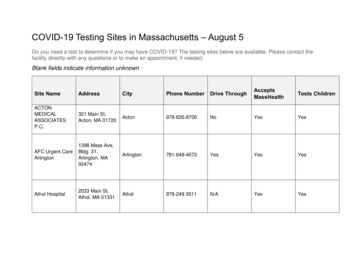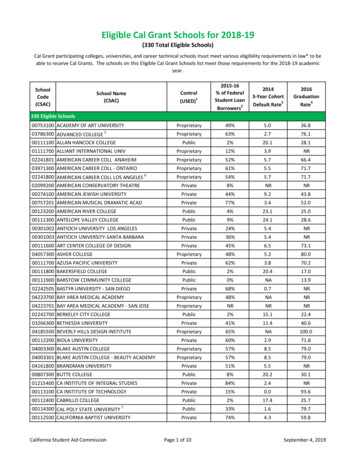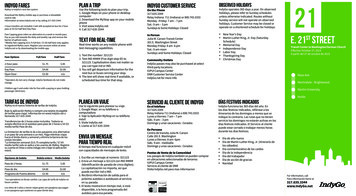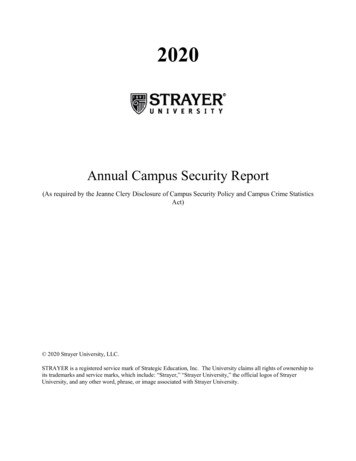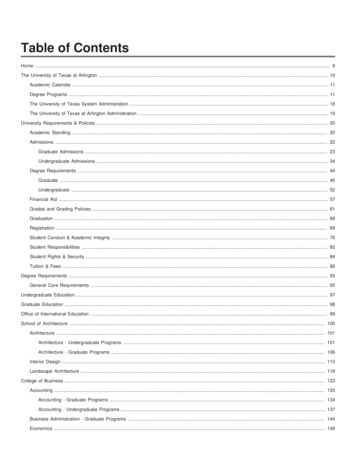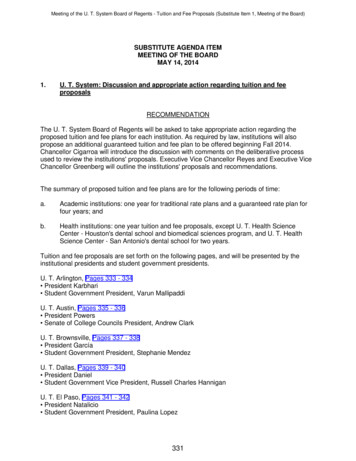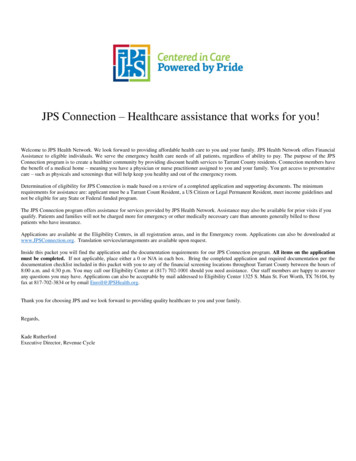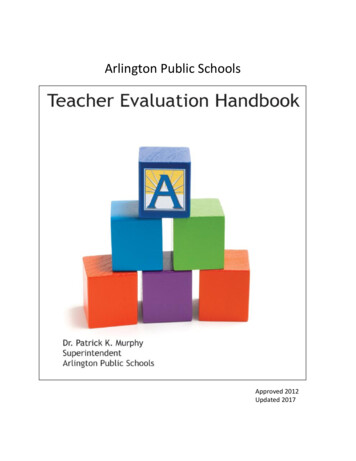
Transcription
Arlington Public SchoolsApproved 2012Updated 2017
ACKNOWLEDGMENTSArlington Public Schools (APS) acknowledge staff who participates each year on theTeacher Evaluation Advisory Committee.We also thank and acknowledge the work of the following individuals as well as the Center forInnovative Technology and others acknowledged by the Virginia Department of Education in itsrevised Guidelines for Uniform Performance Stands and Evaluation Criteria for Teachers:Project Consultant for the Yourtown Public Schools Teacher Performance Evaluation System James H. Stronge, Ph.D.Heritage Professor of Educational Policy, Planning, and LeadershipCollege of William and MaryWilliamsburg, Virginiawith assistance from:Leslie W. Grant, Ph.D., College of William and MaryVirginia Caine Tonneson, Ph.D., College of William and MaryXianxuan Xu, Ph.D., College of William and Mary*Copyright 2011 by James H. Stronge. James H. Stronge hereby grants school divisions in theCommonwealth of Virginia permission to use, revise, and/or modify the Yourtown Teacher EvaluationSystem, as needed, to meet applicable requirements or other educational purposes. This restrictedcopyright permission is applicable solely for use of such copyrighted material by the VirginiaDepartment of Education and their employees, and within the Virginia Public Schools, includingArlington Public Schools.
Table of ContentsPART I: INTRODUCTION AND PROCESS . 1INTRODUCTION . 1Purposes. 2Overview of the APS Teacher Evaluation Process . 3Cycles of Teacher Evaluation . 5Human Resources Processes. 6T-SCALE PERFORMANCE STANDARDS . 7Performance Standards . 7Performance Indicators. 8DOCUMENTING PERFORMANCE. 1Documentation Log . 10Student or Learner Progress or Program Progress . 13SMART Goal Setting Process . 14Professional Activities Summary . 21Observations . 22Alignment of Performance Standards with Data Sources . 24RATING TEACHER PERFORMANCE . 25Evaluation Cycle . 25Evaluation Schedule . 26Record Keeping . 28MAKING EVALUATION DECISIONS . 28Definitions of Ratings . 28Responsibility for the Ratings . 29Rating Teacher Performance . 30Sample Performance Indicators . 30Performance Rubric . 30Interim Evaluation . 32Summative Evaluation . 32IMPROVING PROFESSIONAL PERFORMANCE . 34Support Dialogue . 34Performance Improvement Plan . 35Implementation of Performance Improvement Plan. 36Resolution of Performance Improvement Plan . 36Employee Response to Evaluation . 37PART II: PERFORMANCE STANDARDS . 38Performance Standard 1: Professional Knowledge/Knowledge of the Learning Community . 41Performance Standard 2: Instructional Planning/Program Planning and Management . 42Performance Standard 3: Instructional Delivery/Program Services . 43Performance Standard 4: Assessment of and for Student Learning/Assessment . 44
Performance Standard 5: Learning Environment/Communication and Collaboration . 45Performance Standard 6: Professionalism . 46Performance Standard 7: Student Academic/Learner or Program Progress . 47PART III: FORMS and ADDITIONAL INFORMATION . 48Introduction . 48Documentation Log Cover Sheet . 49Standard 7: SMART Goal Setting Form . 50Teacher Observation Form . 51Educational Specialist Observation Form . 52Guide to Key Elements of a Lesson Plan . 53Pre-Observation Conference Record . 54Pre-Observation Conference Record for Educational Specialists . 55Standard 6: Professional Activities Summary . 56Interim Evaluation . 57Summative Evaluation . 59Performance Improvement Plan . 63Teacher Evaluation Frequently Asked Questions . 64VA Code, Guidelines, and APS Teacher Evaluation School Board Policies . 67FiguresFigure 1 APS Teacher Summative Evaluation Overview . 4Figure 2 APS Teacher Interim Evaluation Overview. 4Figure 3 Cycles of Teacher Evaluation. 5Figure 4 Sample of Performance Standard and Indicators . 8Figure 5 Data Sources for Teachers . 9Figure 6 Student Feedback. 10Figure 7 Sample Items in a Documentation Log . 11Figure 8 SMART Goal Setting Process . 14Figure 9 Choosing the right goal based on baseline data . 16Figure 10 Acronym for SMART Developing Goals . 17Figure 11 Sample Goals . 17Figure 12 Examples of Data Sources for Monitoring Progress . 20Figure 13 Examples of Strategies to Improve Student Learning . 21Figure 14 Observation Types and Requirements . 23Figure 15 Aligning Multiple Data Sources with Performance Standards . 24Figure 16 Summary of Evaluation Component and Teacher Type . 26Figure 17 Teacher Evaluation Schedule . 27Figure 18 Definitions of Terms Used in Rating Scale . 29Figure 19 Sample Rubric of Teacher/Educational Specialist Performance (Standard 5: LearningEnvironment/Communication and Collaboration) . 31Figure 20 Evidence for End of Year Rating . 33Figure 21 Performance Improvement Plan Purpose, Documentation and Outcomes . 35Figure 22 Form Responsibilities . 48
PART I: INTRODUCTION AND PROCESSINTRODUCTIONThis evaluation handbook reflects mandates adopted by the Virginia Department of Education(VDOE), reflected in the Guidelines for Uniform Performance Standards and Evaluation Criteria forTeachers and the Virginia Standards for the Professional Practice of Teachers approved April 28,2011. These mandates necessitated revisions to the Arlington Public Schools (APS) TeacherEvaluation System.The Arlington Public Schools Teacher Evaluation System (in this handbook “teacher” refers to all TScale employees) provides a balance between structure and flexibility. It is prescriptive in that itdefines common purposes and expectations, thereby guiding effective instructional practice. At thesame time, it provides flexibility, thus allowing for creativity and individual initiative. The goal is tosupport the continuous improvement and development of each teacher by monitoring, analyzing,and applying pertinent data compiled within a system of meaningful feedback.APS MISSIONAPS instills a love of learning in its students and prepares them to be responsible and productiveglobal citizens.APS VISIONAPS is a diverse and inclusive school community, committed to academic excellence and integrity. We provideinstruction in a caring, safe and healthy learning environment, responsive to each student, in collaborationwith parents/guardians and the community.Teacher Evaluation VisionAPS will provide every student with highly effective educators who have the necessary skillsto positively impact student learning and growth and collaborate with colleagues to furtherenhance educational opportunities.Teacher Evaluation MissionThe APS teacher evaluation system supports and maintains high quality educators resulting instudent learning and growth by: establishing an environment of trust, collegiality, and collaboration; providing ongoing and meaningful feedback; and supporting teachers as they reflect on provided feedback and make connections forfurther professional learning and improved student or program achievement.Arlington Public Schools Teacher Evaluation Handbook1
PurposesThe primary purposes of the Teacher Evaluation System are to: optimize student learning and growth, improve the quality of instruction by ensuring accountability for classroom performance andteacher effectiveness, contribute to successful achievement of the goals and objectives defined in the vision,mission, and goals of APS, provide a basis for instructional improvement through productive T-Scale performanceappraisal and professional growth, and implement a performance evaluation system that promotes collaboration between theteacher and evaluator and promotes self-growth, instructional effectiveness, andimprovement of overall job performance.The distinguishing characteristics of the Teacher Evaluation System are: a focus on the relationship between professional performance and improved learner growth, sample performance indicators for each of the teacher performance standards, a system for documenting teacher performance based on multiple data sources, a procedure for conducting performance reviews that stresses accountability, promotesprofessional improvement, and increases the involvement of teachers in the evaluationprocess, and identifying assistance when needed.Arlington Public Schools Teacher Evaluation Handbook2
Overview of the APS Teacher Evaluation ProcessThe APS Teacher Evaluation System has set requirements for all teachers. Figure 1 graphicallyprovides an overview of the system.As a part of the evaluation system all teachers will: set student or learner/program progress SMART (specific, measurable, appropriate, realistic,and time limited) goals at the beginning of each school year. The results of the SMART goalsare submitted and reflected on annually. This addresses the VDOE requirement for studentacademic progress to be included as 40% of a teacher’s evaluation. reflect on the commentary provided by the evaluator through the documented announcedand unannounced observations.o Probationary teachers are required to have three documented observations a year.o Continuing contract teachers will have an observation in year 3 of the 3-year cycle(see figure 3) as a part of the evaluation process.o Part-time teachers will have one observation each year. keep a documentation log in which they will submit one piece of evidence per standard perevaluation cycle (see figure 3), including lesson plans as required. summarize professional activities. participate in a mid-year review. receive a summative evaluation at the end of the cycle (see figure 3).o Probationary and part-time teachers’ cycle is one year.o Continuing contract teachers’ cycle is three years.Continuing contract teachers will receive an interim evaluation in years 1 and 2 of the 3-yearevaluation cycle.Arlington Public Schools Teacher Evaluation Handbook3
Figure 1 APS Teacher Summative Evaluation OverviewFigure 2 APS Teacher Interim Evaluation OverviewA teacher may view the number of T-Scale years completed in the Self-Service feature of STARS. Ifa teacher has questions about contract status, contact Human Resources.Arlington Public Schools Teacher Evaluation Handbook4
Cycles of Teacher EvaluationFigure 3 includes the details of the Teacher Evaluation Cycles determined by the year of T-Scaleservice with APS. Staff can verify years of T-Scale service completed with APS in the HumanResources management system. For example, a teacher in year 4 of APS T-Scale service is in year 1 ofthe 3-year continuing contract cycle. Teachers will move into the cycle based on their years ofservice. For example, a teacher in the 11th year of service will move into the new process in year 2of the cycle, then in the following year complete year 3- of the cycle with only two years of evidence.If a teacher has questions about contract status, contact Human Resources or verify on the yearlyassignment letter.Figure 3 Cycles of Teacher EvaluationCurrent Year ofAPS 324Full-Time TeacherPart-Time TeacherThree YearsOne YearProbation Probation Probationary cycleProbationary cycleProbationary cycle(Summative Evaluation)(Summative Evaluation)One observation(SummativeProbationary cycleYear 1 of 2-year cycleEvaluation)(Summative Evaluation)(Interim Evaluation)Probationary cycleYear 2 of 2-year cycle observation(Summative Evaluation)(Summative Evaluation)Year 1 of continuing contract cycle (Interim Evaluation)Year 2 of continuing contract cycle (Interim Evaluation)Year 3 of continuing contract cycle observation (Summative Evaluation)Year 1 of continuing contract cycle (Interim Evaluation)Year 2 of continuing contract cycle (Interim Evaluation)Year 3 of continuing contract cycle observation (Summative Evaluation)Year 1 of continuing contract cycle (Interim Evaluation)Year 2 of continuing contract cycle (Interim Evaluation)Year 3 of continuing contract cycle observation (Summative Evaluation)Year 1 of continuing contract cycle (Interim Evaluation)Year 2 of continuing contract cycle (Interim Evaluation)Year 3 of continuing contract cycle observation (Summative Evaluation)Year 1 of continuing contract cycle (Interim Evaluation)Year 2 of continuing contract cycle (Interim Evaluation)Year 3 of continuing contract cycle observation (Summative Evaluation)Year 1 of continuing contract cycle (Interim Evaluation)Year 2 of continuing contract cycle(Interim Evaluation)Year 3 of continuing contract cycle observation (Summative Evaluation)Year 1 of continuing contract cycle (Interim Evaluation)Year 2 of continuing contract cycle (Interim Evaluation)Year 3 of continuing contract cycle observation (Summative Evaluation)Arlington Public Schools Teacher Evaluation Handbook5
Human Resources ProcessesThe term site administrator will be used for principals or administrators who oversee thebuilding or site. A site administrator may designate an administrator to collect information onemployee job performance. In that case, the site administrator remains informed of theassessment process and agrees with and supports the summative evaluation of the teacher.The term evaluator is used throughout this document to describe those that are assigned asevaluators of teachers, for example: administrators, principals, assistant principals, supervisors,directors of counseling and directors of student activities.When teachers work at more than one location, the site administrators, with assistance ofHuman Resources if needed, will determine who the primary evaluator is.This handbook describes the evaluation process for teachers as well as educational specialists.Examples of T-Scale educational specialists include:1. Central Office Specialists2. Counselors3. Librarians4. Physical, Occupational, and Speech Therapists5. School Psychologists6. Social WorkersArlington Public Schools Teacher Evaluation Handbook6
T-SCALE PERFORMANCE STANDARDSClearly defined professional responsibilities constitute the foundation of the Teacher EvaluationSystem. An evaluation system provides details so that both teachers and evaluators (i.e., siteadministrator or designee) reasonably understand the performance expectations.The expectations for professional performance are defined using a two-tiered approachincluding performance standards and performance indicators.Performance StandardsPerformance standards refer to the major duties performed. There are seven performancestandards for all teachers.Teacher Performance Standards1: Professional KnowledgeThe teacher demonstrates an understanding of the curriculum,subject content, and the developmental needs of students byproviding relevant learning experiences.2: Instructional PlanningThe teacher plans using the Virginia Standards of Learning, thedivision’s curriculum, effective strategies, resources, and data tomeet the needs of all students.3: Instructional DeliveryThe teacher effectively engages students in learning by using avariety of instructional strategies in order to meet individuallearning needs.4: Assessment of and for Student LearningThe teacher systematically gathers, analyzes, and uses allrelevant data to measure student academic progress, guideinstructional content and delivery methods, and provide timelyfeedback to both students and parents/guardians throughoutthe school year.5: Learning EnvironmentThe teacher uses resources, routines, and procedures to providea respectful, positive, safe, student-centered environment thatis conducive to learning.6: ProfessionalismThe teacher maintains a commitment to professional ethics,communicates effectively, and takes responsibility for andparticipates in professional growth that results in enhancedstudent learning. Teachers collaborate with peers and exhibitprofessionalism in working with students, parents/guardians,and colleagues.7: Student Academic ProgressThe work of the teacher results in acceptable, measurable, andappropriate student academic progress.Educational Specialist Performance Standards1: Knowledge of the Learning CommunityThe educational specialist identifies and addresses the needs ofthe targeted learning community by demonstrating respect forindividual differences and understanding of cultures,backgrounds, and learning needs.2: Program Planning and ManagementThe educational specialist effectively plans, coordinates, andimplements programs and services consistent with establishedguidelines, policies, and procedures.3: Program ServicesThe educational specialist uses knowledge ofsubject/field/technology to implement services and to providesupport for the targeted learning community consistent withestablished standards and guidelines.4: AssessmentThe educational specialist gathers, analyzes, and uses data todetermine learner needs, to measure learner or programprogress, to guide instruction, and to provide timely feedback tolearners, parents/guardians, and staff.5: Communication and CollaborationThe educational specialist communicates and collaborateseffectively with learners, parents/guardians, staff, and thecommunity to support learner learning and well-being.6: ProfessionalismThe educational specialist maintains a commitment toprofessional ethics, demonstrates professional expertise, andparticipates in professional growth. Educational specialistscollaborate with peers and exhibit professionalism in workingwith students, parents/guardians, and colleagues.7: Learner/Program ProgressThe work of the educational specialist results in acceptable andmeasurable learner or program progress based on establishedstandards, division goals, and/or school goals.Arlington Public Schools Teacher Evaluation Handbook7
Performance IndicatorsPerformance indicators have been developed (see Part II) to provide examples of observable,tangible behaviors. These indicators are examples of the types of performance that will occur ifa standard is being successfully met. The list of performance indicators is not limited and allteachers are not expected to demonstrate each performance indicator. Teachers will be rated ateach standard as well as receive an overall rating.Both teachers and evaluators may consult the sample performance indicators for clarification ofwhat constitutes a specific performance standard. For example, performance indicators for theInstructional Delivery/Program Services standard are listed in Figure 44 below.Figure 4 Sample of Performance Standard and IndicatorsPERFORMANCESTANDARD NAMEPerformance Standard 3: Instructional Delivery/Program Planning andManagementPERFORMANCESTANDARDThe teacher effectively engages students in learningby using a variety of instructional strategies in orderto meet individual learning needs.The educational specialist uses knowledge ofsubject/field/ technology to implement services and toprovide support for the targeted learning communityconsistent with established standards and guidelines.Examples of teacher work conducted in theperformance of the standard may include, but arenot limited to: Engages and maintains students in activelearning. Builds upon students’ existing knowledge andskills. Differentiates instruction to meet the students’needs. Reinforces learning goals consistentlythroughout the lesson. Uses a variety of effective instructionalstrategies and resources. Uses instructional technology to enhancestudent learning. Communicates clearly and checks forunderstanding.Examples of educational specialist work conducted inthe performance of the standard may include, butPERFORMANCEarenot limited to:INDICATORS Engages and maintains learners/program inactive learning/participation. Presents information and services using variedstrategies to meet learner needs and diversity. Uses technology, materials, and other resourcesas appropriate to deliver services and programs. Communicates clearly and checks forunderstanding.The performance indicators help teachers and their evaluators clarify job expectations. Allperformance indicators may not be applicable to a particular work assignment. Ratings are givenat the performance standard level, not at the indicator level (see Part II). The professionaljudgment of the evaluator in determining at which level the preponderance of evidence fallsplays an important role in measuring the teacher’s level of performance.Arlington Public Schools Teacher Evaluation Handbook8
DOCUMENTING PERFORMANCEA performance evaluation system includes multiple data sources.The data sources briefly described inFigure 55 below provide feedback on teacher performance.The Code of Virginia requires theuse of observation and measures ofacademic progress. APS chose toinclude SMART goal setting,documentation logs, lesson plansand a summary of professionalactivities as other data sources.Figure 5 Data Sources for TeachersData SourceDocumentationLogDefinitionThe Documentation Log includes both specific required artifacts and teacherselected artifacts that provide evidence of meeting selected performancestandards. Teachers, each evaluation
Arlington Public Schools Teacher Evaluation Handbook 2 Purposes The primary purposes of the Teacher Evaluation System are to: optimize student learning and growth, improve the quality of instruction by ensuring accountability for classroom performance and teacher effectiveness,
